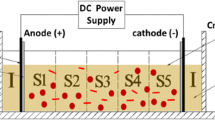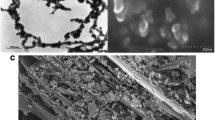Abstract
Bench-scale soil column experiments were carried out to evaluate the effectiveness of Cr(VI) bioremediation process in soils by using indigenous bacteria with the addition of bacteria nutrient media. Effects of particle size, spray intensity, initial Cr(VI) concentration, circulation mode and soil depth on Cr(VI) remediation were studied. Results show that soils after 6 d remediation with spray intensity controlled in the range of 29.6–59.2 mL/min could well fulfill the requirement of concrete aggregate and roadbed material usage, for the leaching toxicity concentration of the Cr(VI) in treated soils under the chosen condition is far less than 5 mg/L. The leaching toxicity and fractions of both hexavalent chromium and trivalent chromium from remediated soils were determined and compared with that of untreated soil. The results show that water soluble Cr(VI) declines from 1520.54 mg/kg to 0.68 mg/kg, exchangeable Cr(VI) decreases from 34.83 mg/kg to 0.01 mg/kg and carbonates-bonded Cr(VI) falls from 13.55 mg/kg to 0.68 mg/kg. Meanwhile, a corresponding increase in carbonate-bonded Cr(III), Fe and Mn oxides-bonded Cr(III) and organic matter-bonded Cr(III) are found. It reveals that indigenous bacteria can leach out water soluble Cr(VI), exchangeable Cr(VI) and carbonates-bonded Cr(VI) from contaminated soil followed by converting into carbonate-bonded Cr(III), Fe and Mn oxides-bonded Cr(III), organic matter-bonded Cr(III) and residual Cr(III).
Similar content being viewed by others
References
CHEUNG K H, GU Ji-dong. Mechanism of hexavalent chromium detoxification by microorganisms and bioremediation application potential: A review [J]. International Biodeterioration & Biodegradation, 2007, 59(1): 8–15.
PATRA R C, MALIK S, BEER M, MEGHARAJ M, NAIDU R. Molecular characterization of chromium (VI) reducing potential in Gram positive bacteria isolated from contaminated sites [J]. Soil Biology and Biochemistry, 2010, 42(10): 1857–1863.
COLIN V L, VILLEGAS L B, ABATE C M. Indigenous microoganisms as potential bioremediators for environments contaminated with heavy metals [J]. International Biodeterioration & Biodegradation, 2012, 69: 28–37.
JEYASINGH J, PHILIP L. Bioremediation of chromium contaminated soil: Optimization of operating parameters under laboratory conditions [J]. Journal of Hazardous Materials, 2005, 118(1/2/3): 113–120.
WANG Yun-yan, YANG Zhi-hui, CHAI Li-yuan, ZHAO Kun. Diffusion of hexavalent chromium in chromium-containing slag as affected by microbial detoxification [J]. Journal of Hazardous Materials, 2009, 169(1/2/3): 1173–1178.
KRISHNA K R, PHILIP L. Bioremediation of Cr(VI) in contaminated soils [J]. Journal of Hazardous Materials, 2005, 121(1/2/3): 109–117.
MASOOD F, AHMAD M, ANSARI M A, MALIK A. Prediction of biosorption of total chromium by Bacillus sp. using artificial neural network [J]. Bull Environ Contam Toxicol, 2012, 88: 563–570.
SHUKLA O P, RAI U N, DUBEY S. Involvement and interaction of microbial communities in the transformation and stabilization of chromium during the composting of tannery effluent treated biomass of Vallisneria spiralis L. [J]. Bioresource Technology, 2009, 100(7): 2198–2203.
CHENG Guo-jun, LI Xiao-hua. Bioreduction of chromium (VI) by Bacillus sp. isolated from soils of iron mineral area [J]. European Journal of Soil Biology, 2009, 45(5/6): 483–487.
SAHINKAYA E, ALTUN M, BEKTAS S, KOMNITSAS K. Bioreduction of Cr(VI) from acidic wastewaters in a sulfidogenic ABR[J]. Minerals Engineering, 2012, 32: 38–44.
LEE S E, LEE J U, CHON H T, LEE J S. Reduction of Cr(VI) by indigenous bacteria in Cr-contaminated sediment under aerobic condition[J]. Journal of Geochemical Exploration, 2008, 96(2/3): 144–147.
POOPAL A C, LAXMAN R S. Studies on biological reduction of chromate by Streptomyces griseus [J]. Journal of Hazardous Materials, 2009, 169(1/2/3): 539–545.
MARTINS M, FALEIRO M L, CHAVES S, TENREIRO R. Anaerobic bio-removal of uranium (VI) and chromium (VI): Comparison of microbial community structure [J]. Journal of Hazardous Materials, 2010, 176(1/2/3): 1065–1072.
SHASHIDHAR T, PHILIP L, BHALLAMUDI S M. Bench-scale column experiments to study the containment of Cr(VI) in confined aquifers by bio-transformation[J]. Journal of Hazardous Materials, 2006, 131(1/2/3): 200–209.
UMRANIA V V. Bioremediation of toxic heavy metals using acidothermophilic autotrophes [J]. Bioresource Technology, 2006, 97(10): 1237–1242.
JEYASINGH J, SOMASUNDARAM V, PHILIP L, BHALLAMUDI S M. Bioremediation of Cr(VI) contaminated soil/sludge: Experimental studies and development of a management model [J]. Chemical Engineering Journal, 2010, 160(2): 556–564.
JASTIN S, MADONA L P, MRUDULA P, MJOYCE N, NATARAJAN C, AMITAVE M. Hexavalent chromium bioremoval through adaptation and consortia development from sukinda chromite mine isolates [J]. Industrial & Engineering Chemistry Research, 2012, 51(9): 3740–3749.
CHAI Li-yuan, HUANG Shun-hong, YANG Zhi-hui, PENG Bing, HUANG Yan, CHEN Yue-hui. Cr (VI) remediation by indigenous bacteria in soils contaminated by chromium-containing slag[J]. Journal of Hazardous Materials, 2009, 167(1/2/3): 516–522.
TESSIER A, CAMPBELL P G C, BISSON M. Sequential extraction procedure for the speciation of particulate trace metals[J]. Analytical Chemistry, 1979, 51(7): 844–851.
KAPOOR A, VIRARAGHAVAN T. Fungal biosorption-an alternative treatment option for heavy metal bearing wastewaters: a review [J]. Bioresource Technology, 1995, 53(3): 195–206.
UA Environmental Protection Agency. Environment protection agency office of solid waste. Hazardous waste characteristics scoping study [M]. Washington DC: USA Environmental Protection Agency, 1996: 2–14.
HJ/T 301-2007. Environmental protection technical specifications for pollution treatment of the Chromium residue (on trial) [S]. (in Chinese)
SIGUA G, ISENSEE A, SADEGHI A M. Influence of rainfall intensity and crop residue on leaching of atrazine through intact no-till soil cores[J]. Soil Science, 1993, 156(4): 225–232.
GHEJU M, IOVI A. Kinetics of hexavalent chromium reduction by scrap iron[J]. Journal of Hazardous Materials, 2006, 135(1/2/3): 66–73.
Author information
Authors and Affiliations
Corresponding author
Additional information
Foundation item: Project(50925417) supported by the National Funds for Distinguished Young Scientist, China; Project(50830301) supported by the Key Program of National Natural Science Foundation of China; Project(51074191) supported by the National Natural Science Foundation of China
Rights and permissions
About this article
Cite this article
Li, Q., Yang, Zh., Chai, Ly. et al. Optimization of Cr(VI) bioremediation in contaminated soil using indigenous bacteria. J. Cent. South Univ. 20, 480–487 (2013). https://doi.org/10.1007/s11771-013-1509-8
Received:
Accepted:
Published:
Issue Date:
DOI: https://doi.org/10.1007/s11771-013-1509-8




